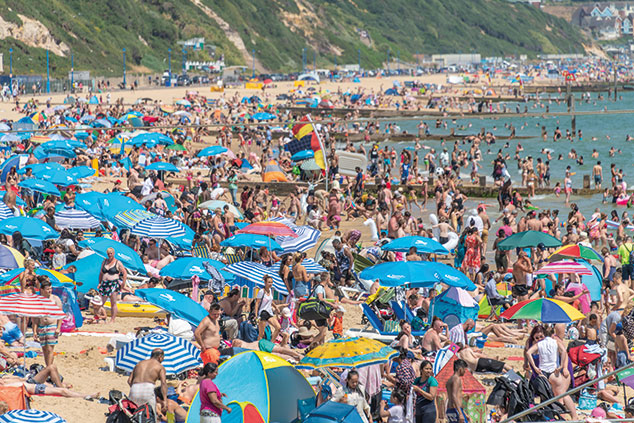
The earth may be on an unstoppable trajectory towards a “hothouse” climate that will see 200ft sea-level rises and render huge swathes of the planet uninhabitable, says Ben Webster in The Times. A study by the National Academy of Sciences says that reducing the rise in global average temperatures to below 2ºC, the goal of the 2015 Paris agreement, may not be enough to prevent an array of feedback mechanisms – from permafrost thaw to Amazon rainforest dieback – from releasing more carbon into the atmosphere.
These “tipping elements can potentially act like a row of dominoes”, says Johan Rockström, one of the study’s authors, resulting in another 2ºC-3ºC of warming, with temperatures eventually stabilising at a global average of 4ºC-5ºC higher than the pre-industrial average – the “Hothouse Earth” scenario. Global warming will have many repercussions, from crop failure to migration, says Greg Ip in The Wall Street Journal.
To that list we can now add “heat-related damage” following the publication of a new study that finds that, by the year 2099, after taking adaptation into account, the annual global death toll from higher temperatures will rise by 1.5 million people.
Can humanity avert disaster?
To avert disaster, the authors say that a “deep transformation” is required, based on a “fundamental reorientation of human values, equity, behaviour, institutions, economies and technology”, says Sarah Knapton in The Daily Telegraph. However, Chris Rapley, professor of climate science at University College London (UCL), says it seems “naïve” to hope that humanity can “navigate the planet to an acceptable intermediate state”, particularly at a time when populism is on the rise and climate-change denial remains.
“Dystopia is easy to envisage,” says Simon Lewis, professor of global change science at UCL, in The Guardian. But “taking a step back from the gloom”, we face the same three choices as we have since the warnings began 30 years ago: mitigate the effects (by reducing emissions), adapt, or suffer the consequences.
Despite this “basic advice” being decades old – indeed, as Philip Johnston notes in The Daily Telegraph, in 1988, Margaret Thatcher became among the first mainstream politicians to sound the warning on climate change in a speech to the Royal Society – we are heading for “some mitigation, very little adaptation and a lot of suffering”, says Lewis. This has to change, and change ultimately is “about power, money and political will”.
Thinking about the climate “as a practical political problem helps avoid despair as we know that huge political changes have happened in the past… Given the colossal wealth and… scientific knowledge available today, we can solve many of the world’s pressing problems and all live well”.
The tipping point
This scorching summer may mark a “historical tipping point”, says Michael McCarthy in The Guardian. From the first report by the UN’s Intergovernmental Panel on Climate Change in May 1990, the dangers have been based on the predictions of supercomputer models – essentially the same models that forecast the weather a few days in advance were being “tasked with forecasting the climate up to 100 years into the future”.
Despite the growing robustness of these models, the uncertainty of predicting the future remains, and this has been a “political weakness”. With the record-breaking heat across the northern hemisphere, people are waking up to the fact that “something abnormal” is happening to the global climate. Observation is starting to replace prediction, and that is significant.
The green belt is turning brown
Tory MP Liz Truss angered colleagues this week after saying the Tories should build houses in the countryside or end up with Jeremy Corbyn – “whose policy appears to be appropriating property” – as prime minister. In a podcast interview with the Financial Times, the chief secretary to the Treasury said that “a lot more land” should be opened up for developers and complained of the number of Nimbys in Britain, says John Stevens in the Daily Mail.
Tory colleagues, however, warned that the party would be “run out of office” if it proceeded with “catastrophic” proposals that “fail to protect rural Britain and the green belt”.
The row came a day after the publication of a report from the Campaign to Protect Rural England (CPRE), which warns that relaxing planning laws means 460,000 houses are pencilled in for the green belt. The defence is that it’s needed to meet building targets and help first-time buyers, says The Daily Telegraph.
Yet the CPRE says 75% of these houses don’t meet the government’s “affordable” criteria. Houses are needed where people want to live, mainly London and the southeast, not where developers can get the highest price. The CPRE says local authorities with green-belt land have enough brownfield sites for 720,000 properties.
The report distracts from the real issue, which is the restoration of county land-use planning, says Simon Jenkins in The Guardian. Policy should be aimed at genuinely boosting supply, which means reducing under-occupation of existing buildings, encouraging downsizing and subletting, not taxing house sales and “densifying urban sites”. Local planning should be restored to grant local people the right to “control settlement in their communities”.
All landscape should be listed, whether for conservation or potential building. “Everyone would know where they stood. Rural Britain would not, as now, be up for speculative land grab.”